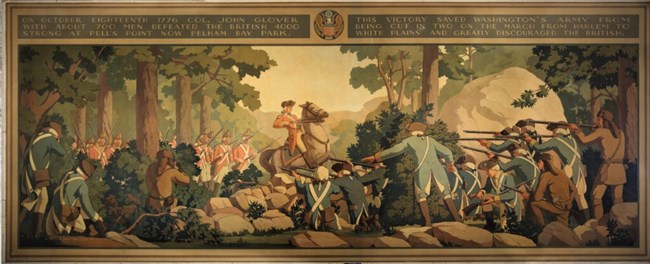Last updated: January 17, 2022
Article
The Battle of Pell's Point

The Battle of Pell’s Point
Pell’s Point was a strategically important but often overlooked Revolutionary War battle fought about a mile from St. Paul’s Church National Historic Site on October 18, 1776. A small American brigade, under the command of Colonel John Glover of Massachusetts, delayed a large British/Hessian army, under the command of General Sir William Howe, helping to cover the retreat of the main body of General Washington’s army from northern Manhattan to White Plains.
The battle was part of the New York area campaign of August through December 1776. This series of battles matched the largest armies of the war in engagements that determined the survival of the American independence movement. In the summer, the British, and their hired Hessian (German) allies, defeated Washington’s forces in battles in Brooklyn and Manhattan. It was only Washington’s ability to direct timely retreats, and General Howe’s unwillingness to aggressively pursue the Patriots, that saved the Americans from destruction. By late September, Washington’s forces were pinned at Harlem Heights in northern Manhattan, with the British army in front and the Royal navy patrolling the Hudson River.
In mid-October, General Howe began a flanking movement that brought the war to Westchester County. Leaving behind a holding force in Manhattan, Howe transported about 4,000 troops up the East River toward Long Island Sound, for a landing at Throgs Neck, today part of the Bronx. Howe’s goal was to cut off the American supply line to Connecticut. The British commander also hoped to draw Washington out in a general engagement, or to smash the American from the right flank while the holding force launched a frontal assault.
Aware that the enemy was landing at his rear, General Washington stationed troops at key points. While he thought the stones fences and marshy land made the approaches his position defensible, the Virginian, fearing possible entrapment, made the important decision to withdraw from northern Manhattan to Westchester. That movement, which put the main American army in a vulnerable position, began on October 18.
On October 12, the British force landed at Throgs Neck, a marshy peninsula, which was actually not part of the mainland. Marching westward toward the King’s Bridge, Howe’s troops were held off by a small group (about 25) of American soldiers at a bridge near Westchester Square, before the Patriots moved more troops into position. Today this is the site of Herbert H. Lehman High School, along the Hutchinson River Parkway.
Early on the morning of October 18, Howe began another amphibious operation, transporting his force around Throgs Neck to Pell’s Point, about three miles further north, at the mouth of the Hutchinson River. Another column marched overland from Westchester Square, and was ferried across Eastchester Bay, at the contemporary site of Co-Op City. Two experienced British officers, Henry Clinton and Charles Cornwallis, directed the landing. The attacking force of approximately 4,000 was led by light infantry, grenadiers and dismounted light dragoon companies drawn from several British regiments. The landing on a beachhead at what is today Pelham Bay Park was largely unopposed. While General Cornwallis led troops to the right on a flanking move, most of the invaders, led by British light infantry and grenadiers , marched up the Shore Road, and veered onto Split Rock Road.
Opposing the Crown forces were four regiments (about 750 soldiers) from Massachusetts, under the command of Colonel Glover. Using St. Paul’s Church as a hospital, Glover’s forces had arrived in the area on October 14, and were arrayed on the west side of the Hutchinson River, along today’s Sandford Blvd. in Mt. Vernon. Rising early on that Friday morning, October 18, Glover ascended a hill, and, with his spyglass, observed the British forces moving into Eastchester Bay.
The 43-year-old colonel quickly moved his troops to check the British/Hessian force. He stationed his regiments, at staggered intervals, behind stone walls that bordered the Split Rock Road. This provided fine secrecy and cover, allowing the Americans to unload numerous musket volleys at close range into the ranks of the surprised Crown soldiers. After those rounds, the Massachusetts men withdrew to join the hidden troops stationed at the next interval, where the same pattern was repeated. The fiercest fighting occurred around the Split Rock, located near today’s confluence of the New England Thruway and the Hutchinson River Parkway.
As more British and eventually blue-coated Hessian troops were brought into the fray, Glover’s position became untenable. In addition, around noon, General Cornwallis completed his flanking movement on the American left and the Patriots faced possible envelopment. Sensing this, Glover ordered a withdrawal across the Hutchinson River, and later in the day a re-deployment north along the road to White Plains, reaching Tuckahoe by nightfall. There was no British effort to pursue Glover’s brigade. Following the action, Hessian forces occupied St. Paul’s Church and, like the American army days before, used it as a field hospital.
The men from Massachusetts had performed an outstanding service. They raised the morale of the American army in the New York theatre, fighting a well ordered defensive battle and only withdrawing when their flanks were threatened with overwhelming numbers. Glover’s troops inflicted dozens of casualties on the enemy. Of equal importance, the brigade gave the main body of the army under General Washington space and time to complete the removal to White Plains.
